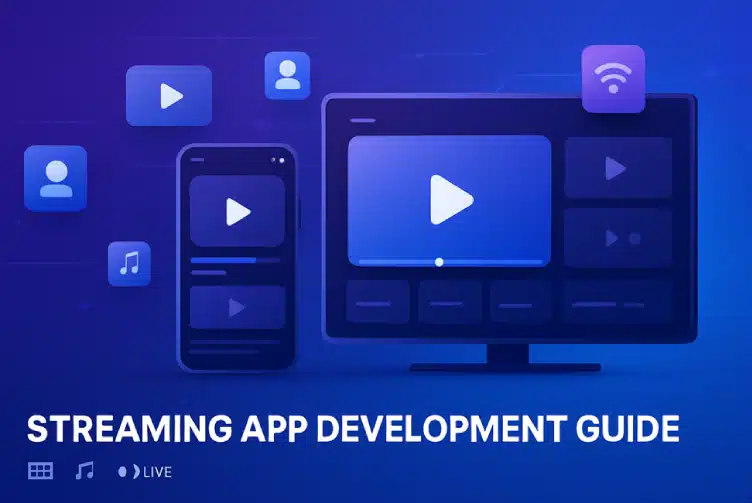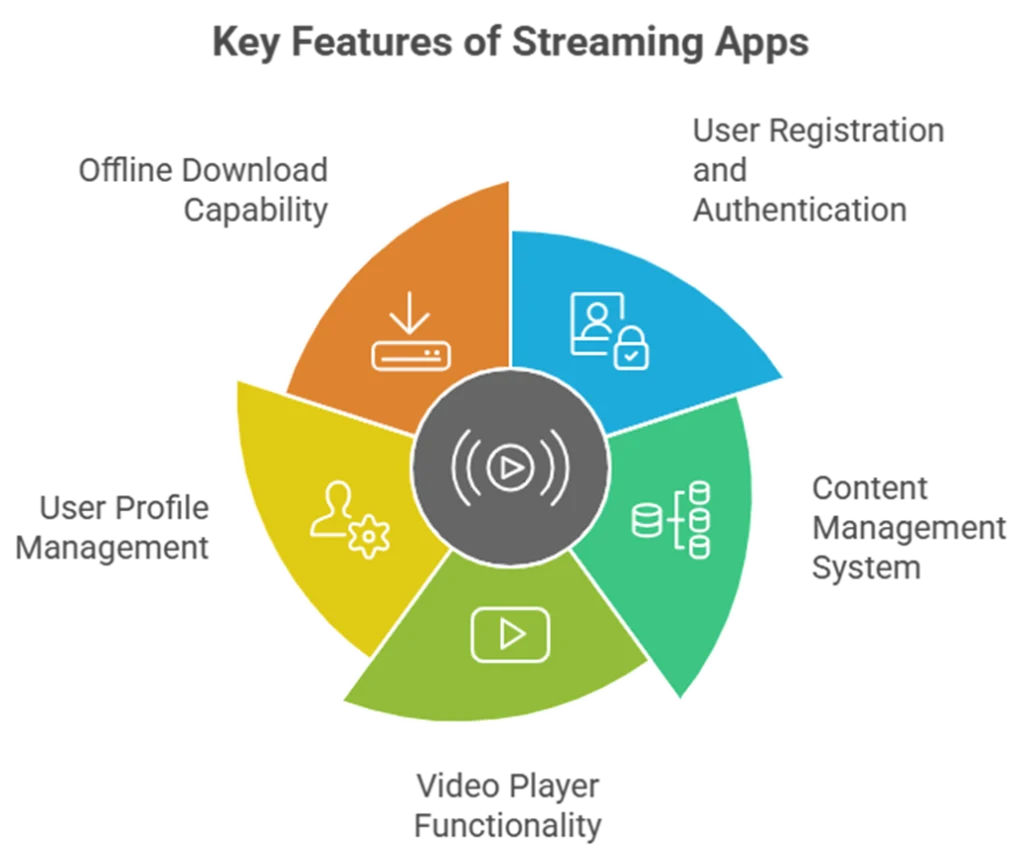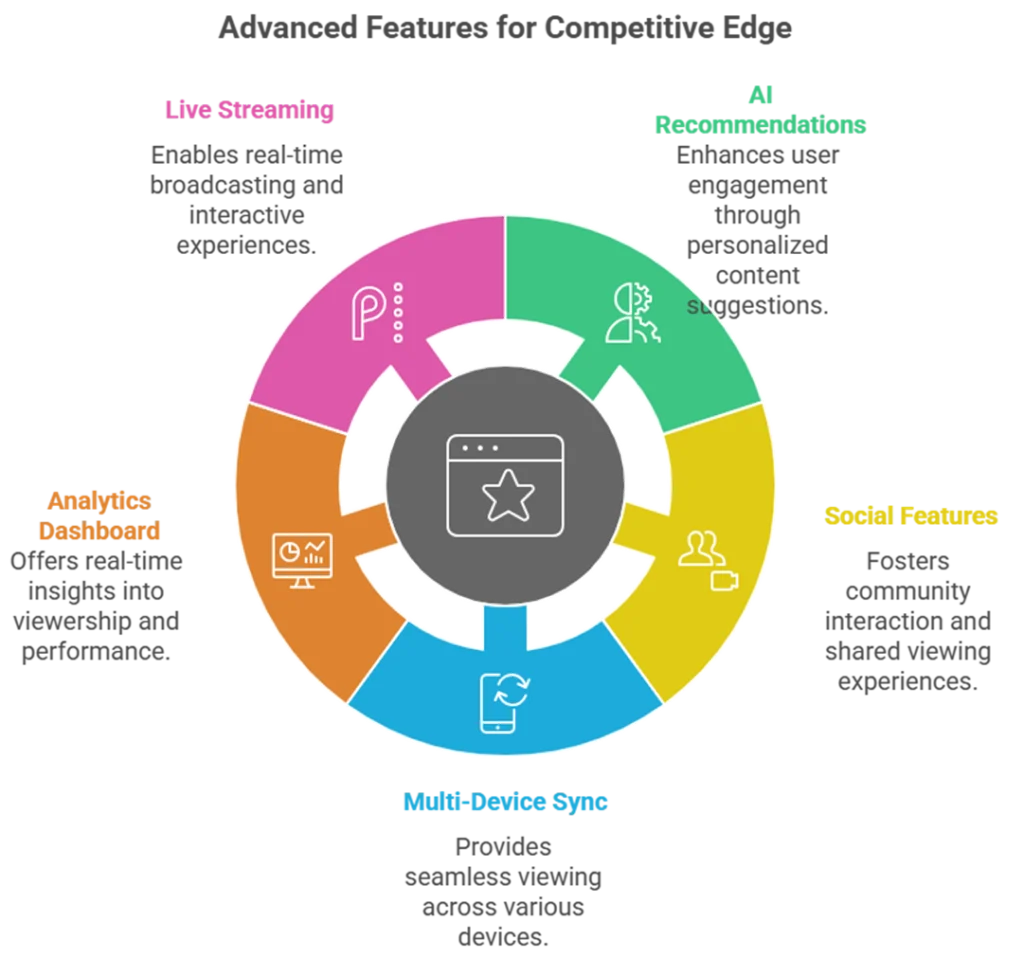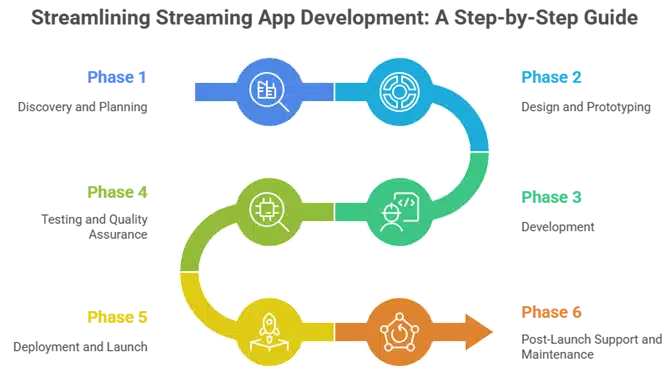
The streaming industry has transformed how we consume content, with global streaming revenue expected to reach $1,721.4 billion by 2030. Whether you’re planning to launch the next Netflix or create a niche streaming platform, this comprehensive guide covers everything you need to know about streaming app development in 2025.
What is Streaming App Development?
Streaming app development is the process of creating applications that deliver audio, video, or multimedia content over the internet in real-time. Unlike traditional download-based models, streaming apps allow users to consume content instantly without storing large files on their devices.
The technology behind streaming apps uses advanced protocols like HLS (HTTP Live Streaming), DASH (Dynamic Adaptive Streaming over HTTP), and WebRTC to ensure smooth, buffer-free content delivery across various devices and network conditions.
Why Invest in Streaming App Development?
Market Growth and Opportunities
The streaming market is experiencing unprecedented growth. According to recent statistics:
- 82% of all internet traffic will be video streaming
- The average user spends 19 hours per week watching streaming content
- 78% of millennials and Gen Z prefer streaming services over traditional TV
This explosive growth presents massive opportunities for businesses to capture market share and build sustainable revenue streams.
Business Benefits
1. Recurring Revenue Model Subscription-based streaming apps provide predictable monthly revenue, making financial planning and growth projections more accurate.
2. Global Reach Streaming apps break geographical barriers, allowing you to reach audiences worldwide without physical distribution networks.
3. Direct Customer Relationships Unlike traditional media distribution, streaming apps give you direct access to your audience, enabling better understanding of viewer preferences and behavior.
4. Lower Distribution Costs Digital distribution eliminates costs associated with physical media production, shipping, and retail margins.
5. Real-time Analytics Track user engagement, content performance, and viewing patterns instantly to make data-driven decisions.
Types of Streaming Apps

1. Video on Demand (VOD) Apps
VOD apps allow users to watch pre-recorded content at their convenience. Examples include:
- Entertainment platforms (movies, TV shows)
- Educational streaming services
- Corporate training platforms
- Fitness and wellness apps
Key Features:
- Extensive content library
- Download for offline viewing
- Multiple user profiles
- Personalized recommendations
2. Live Streaming Apps
Live streaming apps broadcast content in real-time, creating immediate and engaging experiences. Popular categories include:
- Sports broadcasting
- Gaming and esports
- News channels
- Virtual events and conferences
Key Features:
- Low-latency streaming
- Real-time chat and interactions
- Recording capabilities
- Multi-camera support
3. Audio Streaming Apps
Audio streaming focuses on music, podcasts, and audiobooks. These apps require:
- High-quality audio codecs
- Playlist creation and management
- Background playback
- Offline synchronization
4. Hybrid Streaming Platforms
Combining multiple content types, hybrid platforms offer:
- Live and on-demand content
- Audio and video streaming
- Interactive features
- Social elements
Essential Features for Streaming App Development

Core Features Every Streaming App Needs
1. User Registration and Authentication
- Social media login integration
- Email and phone verification
- Secure password management
- Multi-factor authentication
2. Content Management System
- Organized categories and genres
- Content tagging and metadata
- Search and filter functionality
- Content scheduling and publishing
3. Video Player Functionality
- Adaptive bitrate streaming
- Multiple quality options (SD, HD, 4K)
- Playback speed control
- Picture-in-picture mode
- Subtitle and audio track selection
4. User Profile Management
- Multiple user profiles per account
- Viewing history tracking
- Watchlist and favorites
- Parental controls
- Personalized settings
5. Offline Download Capability
- Selective content downloading
- Download quality options
- Storage management
- Expiry date settings
Advanced Features for Competitive Edge

1. AI-Powered Recommendations Machine learning algorithms analyze viewing patterns to suggest relevant content, increasing user engagement and retention.
2. Social Features
- Watch parties for synchronized viewing
- Comments and reviews
- Social media sharing
- User-generated playlists
3. Multi-Device Synchronization
- Continue watching across devices
- Universal watchlist
- Synchronized preferences
- Remote control features
4. Advanced Analytics Dashboard
- Real-time viewership data
- Content performance metrics
- User behavior analysis
- Revenue tracking
5. Live Streaming Capabilities
- Real-time broadcasting
- Interactive features (polls, Q&A)
- Stream recording
- Multi-bitrate encoding
The Streaming App Development Process

Phase 1: Discovery and Planning
Market Research
- Analyze competitor apps and their features
- Identify target audience demographics
- Study market trends and opportunities
- Define unique value proposition
Technical Planning
- Choose streaming protocols and CDN
- Plan server architecture
- Define scalability requirements
- Select technology stack
Feature Prioritization
- Create feature list for MVP
- Plan future feature releases
- Estimate development timeline
- Set budget parameters
Phase 2: Design and Prototyping
User Experience Design
- Create user journey maps
- Design information architecture
- Develop wireframes
- Plan navigation flow
Visual Design
- Establish brand identity
- Create UI components
- Design responsive layouts
- Develop style guide
Prototype Development
- Build interactive prototypes
- Conduct usability testing
- Gather user feedback
- Iterate based on insights
Phase 3: Development
Backend Development
- Set up server infrastructure
- Implement database architecture
- Develop APIs and microservices
- Integrate CDN and streaming protocols
- Implement security measures
Frontend Development
- Develop native mobile apps (iOS/Android)
- Create web application
- Build TV applications
- Ensure cross-platform compatibility
- Implement responsive design
Integration Phase
- Payment gateway integration
- Analytics tools setup
- Third-party service connections
- DRM implementation
- Social media integration
Phase 4: Testing and Quality Assurance
Functional Testing
- Feature verification
- User flow testing
- Cross-platform compatibility
- Payment processing tests
Performance Testing
- Load testing for concurrent users
- Streaming quality assessment
- App performance optimization
- Network condition simulation
Security Testing
- Vulnerability assessment
- Penetration testing
- Data Encryption Verification
- DRM effectiveness testing
Phase 5: Deployment and Launch
Pre-Launch Preparation
- App store optimization
- Marketing material creation
- Beta testing program
- Server scaling preparation
Launch Execution
- Phased rollout strategy
- Performance monitoring
- User feedback collection
- Quick issue resolution
Phase 6: Post-Launch Support and Maintenance
Ongoing Activities
- Regular feature updates
- Performance optimization
- Bug fixes and patches
- Content management support
- User support services
Technology Stack for Streaming App Development
Frontend Technologies
Mobile Development
- Native iOS: Swift, SwiftUI
- Native Android: Kotlin, Jetpack Compose
- Cross-Platform: React Native, Flutter
- Hybrid: Ionic, Xamarin
Web Development
- Frameworks: React.js, Angular, Vue.js
- Video Players: Video.js, Plyr, Shaka Player
- Progressive Web App: Service Workers, Web App Manifest
Smart TV Development
- Platforms: Android TV, Apple TV, Roku, Samsung Tizen
- Frameworks: React Native for TV, Lightning.js
Backend Technologies
Programming Languages
- Node.js for real-time applications
- Python for AI/ML integration
- Java for enterprise solutions
- Go for high-performance systems
Frameworks and Tools
- Express.js, Fastify (Node.js)
- Django, FastAPI (Python)
- Spring Boot (Java)
- Gin, Echo (Go)
Databases
- SQL: PostgreSQL, MySQL
- NoSQL: MongoDB, Cassandra
- Cache: Redis, Memcached
- Search: Elasticsearch
Streaming Infrastructure
Content Delivery Networks (CDN)
- Amazon CloudFront
- Cloudflare Stream
- Akamai
- Fastly
Streaming Protocols
- HLS (HTTP Live Streaming)
- DASH (Dynamic Adaptive Streaming)
- RTMP (Real-Time Messaging Protocol)
- WebRTC (Web Real-Time Communication)
Video Processing
- FFmpeg for transcoding
- AWS Elemental MediaConvert
- Wowza Streaming Engine
- GStreamer
Cloud Platforms
- Amazon Web Services (AWS)
- Google Cloud Platform (GCP)
- Microsoft Azure
- DigitalOcean
Monetization Strategies for Streaming Apps
1. Subscription Video on Demand (SVOD)
The most popular model, used by Netflix and Disney+, offers:
- Predictable recurring revenue
- Multiple tier options
- Free trial periods
- Family plan options
Best Practices:
- Offer competitive pricing
- Provide exclusive content
- Regular content updates
- Flexible cancellation policies
2. Advertising Video on Demand (AVOD)
Free content supported by advertisements, like YouTube:
- Pre-roll, mid-roll, and post-roll ads
- Banner advertisements
- Sponsored content
- Targeted advertising
Implementation Tips:
- Balance ad frequency
- Ensure relevant ad targeting
- Provide skip options
- Maintain streaming quality
3. Transactional Video on Demand (TVOD)
Pay-per-view model for premium content:
- New rental release
- Purchase options
- Event-based content
- Time-limited access
Success Factors:
- Competitive pricing
- High-quality content
- Easy payment process
- Clear rental terms
4. Hybrid Monetization Models
Combining multiple revenue streams:
- Freemium with premium upgrades
- Ad-supported free tier with ad-free subscription
- Subscription plus premium rentals
- Bundled services
Best Practices for Successful Streaming App Development
1. Prioritize User Experience
- Design intuitive navigation
- Minimize clicks to content
- Implement smart search with filters
- Provide seamless onboarding
- Enable quick content discovery
2. Ensure High Performance
- Optimize app loading times
- Implement efficient caching strategies
- Use lazy loading for content
- Minimize app size
- Regular performance monitoring
3. Focus on Content Discovery
- Implement AI-driven recommendations
- Create curated collections
- Enable advanced search filters
- Show trending content
- Personalize home screens
4. Implement Robust Security
- Use industry-standard DRM
- Implement secure authentication
- Encrypt data transmission
- Regular security audits
- Comply with data protection regulations
5. Plan for Scalability
- Design modular architecture
- Use microservices approach
- Implement load balancing
- Plan for traffic spikes
- Regular stress testing
Future Trends in Streaming App Development
1. Artificial Intelligence and Machine Learning
AI is revolutionizing streaming apps through:
- Ultra-personalized content recommendations
- Automated content tagging and categorization
- Predictive analytics for content creation
- Voice-controlled interfaces
- Automated quality optimization
2. 5G Technology Integration
5G networks will enable:
- Ultra-low latency streaming
- Higher quality video (8K support)
- Enhanced mobile streaming experience
- Better live streaming capabilities
- Reduced buffering issues
3. Interactive and Immersive Content
The future includes:
- Choose-your-own-adventure content
- Virtual reality streaming
- Augmented reality integration
- 360-degree video content
- Interactive live events
4. Blockchain and Decentralization
Emerging applications include:
- Decentralized content distribution
- Smart contracts for royalty payments
- Transparent content rights management
- Cryptocurrency payment options
- NFT integration for exclusive content
5. Social Viewing Experiences
Growing trends include:
- Synchronized watch parties
- Real-time reactions and comments
- Social media integration
- Collaborative playlists
- Virtual viewing rooms
Why Choose ideyaLabs for Your Streaming App Development?
Our Expertise
With over 5+ years of experience in Streaming App Development, ideyaLabs has successfully delivered streaming applications across various industries. Our team of skilled developers specializes in creating scalable, feature-rich streaming platforms that engage users and drive business growth.
Our Approach
1. Client-Centric Development We begin every project by understanding your unique business goals, target audience, and market position to create tailored solutions.
2. Agile Methodology Our agile development process ensures flexibility, regular updates, and the ability to adapt to changing requirements.
3. Quality Assurance Rigorous testing protocols ensure your streaming app performs flawlessly across all devices and network conditions.
4. Post-Launch Support We provide comprehensive maintenance and support services to ensure your app continues to perform optimally.
Our Services
- End-to-end streaming app development
- Backend infrastructure setup
- CDN integration and optimization
- DRM implementation
- Payment gateway integration
- Analytics and reporting setup
- Ongoing maintenance and support
Success Stories
Our portfolio includes streaming apps for:
- Regional OTT platforms
- Educational institutions
- Fitness and wellness brands
- Corporate training solutions
- Live event broadcasting
Conclusion
Streaming app development represents one of the most exciting opportunities in the digital landscape. With the right strategy, technology, and development partner, you can create a streaming platform that captures audience attention and generates sustainable revenue.
The key to success lies in understanding your target audience, implementing the right features, choosing appropriate technology, and ensuring scalability for future growth. Whether you’re planning to launch a niche streaming service or compete with industry giants, the opportunities are limitless.
At ideyaLabs, we combine technical expertise with industry insights to help you navigate the complexities of streaming app development. From initial concept to post-launch support, we’re committed to turning your streaming app vision into a successful reality.